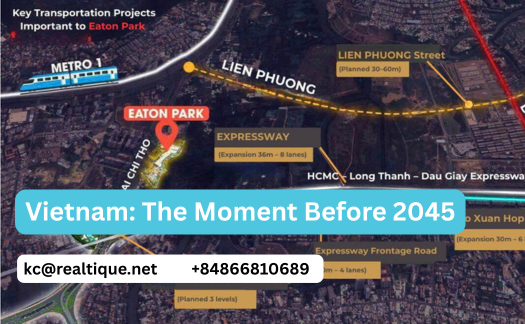Vietnam: The Moment Before 2045
Table of Contents
Earlier this month, I had the chance to travel to Japan — spending a few days in Tokyo and visiting Osaka for the Expo. It was a 7-day trip, with each day involving 15–17 km of walking. I explored everything from Shibuya’s small alleys filled with ramen, udon, sushi, and cozy bars, to the high hills of Osaka with breathtaking views of Fujisan.
The Learning Journey
There was so much to see, and even more to learn. I was surprised at how advanced Japan has become: from multi-layered Metro systems to different kinds of trash bins, and urban designs so efficient that even a place to sit and rest is rare.
It reflects the lifestyle of most people there — busy commuting between home and work — so why bother placing benches or trash bins?
Japan feels like a fully developed country, yet without room for further development. In many areas — technology, services, entrepreneurship — competition has already peaked.
When I returned to Vietnam, I realized for the first time in my 36 years how underdeveloped it still is.
For example: our trash bins are divided into two types — recycled and non-recycled — yet everything gets mixed together at the collection point. Why? Because unlike Japan, Vietnam hasn’t yet built the next step of turning waste into energy or new products.
Or look at the Metro: Ho Chi Minh City spent 15 years building its first line, while Tokyo operates three different systems — underground, express, and inter-provincial — on what seems like a godlike level.
The Power of Now
Yet this contrast reveals something powerful: there is enormous potential for growth in Vietnam. Suddenly, I understood why some foreigners call Vietnam a heaven for business ideas.
The government is channeling resources into infrastructure, airports, highways, and schools, aiming to achieve developed-country status by 2045.
2045? Just 20 years from now. I’ll be 56 by then. 🙂
Of course, a “developed Vietnam” will not look exactly like Japan or others. By then, the very definition of a developed country may have changed.
But here’s the truth: this is the only time we will experience Vietnam in its journey toward development. After 2045, that window of transformation will be gone.
Can Vietnam reach this goal?
The likely answer: YES.
Why? Because the patterns point in only one direction. For the last 10 years, six key indicators have consistently stayed high: GDP, import–export, FDI, CPI, tourism, and retail & consumer revenue.
The Big Picture
In West Ho Chi Minh City, massive capital is pouring into infrastructure:
Long Thanh International Airport
An Phu Intersection
Lien Phuong Street
Expansion of HCMC–Long Thanh Expressway
Meanwhile, politics remains stable, and the government is steering with both long-term and short-term strategies.
On September 5th, Vietnam’s School Opening Day, the Politburo released Decree 71, putting education at the center of development. Goals include: English as the second national language, one Vietnamese university in the world’s top 100, 85% of schools meeting new standards, and more.
This is only the tip of the iceberg. Every day, people and policymakers are working toward the 2045 vision.
Real Estate Bubble?
Yes, it will happen — but after 2045.
From now until then, Vietnam’s real estate will follow a clear growth trajectory. The time to profit is now, while there is still room for development.
Problems with Solutions Are Goldmines
Recent projects in Ho Chi Minh City are no longer in prime central districts. Many are being pushed to Binh Duong or locations an hour away from the city center.
But projects like Global City, The Privé, and Eaton Park have far more favorable positions — only 10–15 minutes from District 1.
When I drove around Eaton Park, I noticed heavy traffic from container trucks and cars, with 120-second red lights at An Phu Intersection. At 7:30 AM, there’s no shortcut to avoid congestion if you’re heading downtown, and reaching Thao Dien requires taking a longer detour under Rach Chiec Bridge.
These are real problems — but they come with real solutions. Construction is already underway:
By 2026, the 3-layer An Phu Intersection will be complete.
By 2028, Long Thanh Airport will partially open, forcing further expansion of the HCMC–Long Thanh Expressway.
Price of Eaton Park
As the only project currently launching in this neighborhood, Eaton Park’s final phase is priced at about 220M VND/sqm.
By the time Eaton Park completes in 2027, supported by new infrastructure, prices will rise — and continue climbing toward the 2045 peak.
So the questions are:
Will you join now to capture this growth?
Do you want more details about neighborhood developments such as Saigon Sport City or An Phu Intersection?
What factors assure the profit potential of Eaton Park?
Let’s keep the discussion open. If you have further questions or would like to talk more about this opportunity, contact me today at +84 866 810 689 for a personalized consultation.






